 Weird Stuff
Weird Stuff  Weird Stuff
Weird Stuff  Animals
Animals 10 Inspiring Tales of Horses Being Human
 Mysteries
Mysteries Top 10 Haunting Facts About the Ghost Ship MV Alta
 History
History 10 Surprising Stories About the Texas Rangers
 Humans
Humans 10 Philosophers Who Were Driven Mad by Their Own Theories
 Miscellaneous
Miscellaneous 10 Video-Game-Worthy Weapons and Armors from History
 Weird Stuff
Weird Stuff 10 Psychics Who Accurately Predicted Wartime Events
 The Arts
The Arts 10 Pieces of Art Inspired by a Broken Heart
 Health
Health 10 Science Fiction-Sounding New Medical Treatments
 History
History 10 Surprising Facts About the Father of Submarine Warfare
 Weird Stuff
Weird Stuff 10 Times Real Laws Were Based on Bizarre Hypotheticals
 Animals
Animals 10 Inspiring Tales of Horses Being Human
 Mysteries
Mysteries Top 10 Haunting Facts About the Ghost Ship MV Alta
Who's Behind Listverse?

Jamie Frater
Head Editor
Jamie founded Listverse due to an insatiable desire to share fascinating, obscure, and bizarre facts. He has been a guest speaker on numerous national radio and television stations and is a five time published author.
More About Us History
History 10 Surprising Stories About the Texas Rangers
 Humans
Humans 10 Philosophers Who Were Driven Mad by Their Own Theories
 Miscellaneous
Miscellaneous 10 Video-Game-Worthy Weapons and Armors from History
 Weird Stuff
Weird Stuff 10 Psychics Who Accurately Predicted Wartime Events
 The Arts
The Arts 10 Pieces of Art Inspired by a Broken Heart
 Health
Health 10 Science Fiction-Sounding New Medical Treatments
 History
History 10 Surprising Facts About the Father of Submarine Warfare
Top 10 Unusual Shoreline Finds
Every day, the oceans crash upon countless beaches. More often than not, oddities arrive between the usual flotsam of shells. There is always the mandatory monster’s carcass and real species so surprising that few can recognize them.
The most bizarre shoreline finds are usually man-made. From large pieces of foreign harbors to hundreds of Garfields, beachcombing is the lucky dip of the sea.
10 Enormous Sunfish
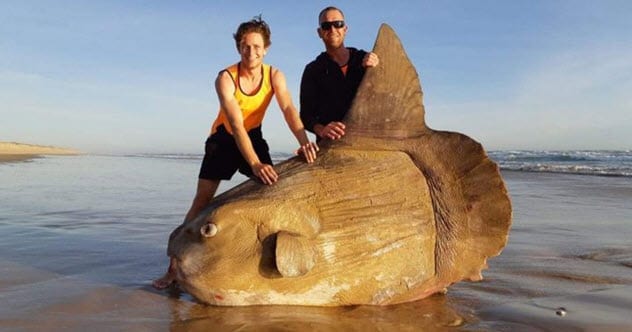
In 2019, a couple strolled along a beach in South Australia. When they reached Murray River, something caught their eye. Near the mouth of the river was a huge object. At first, they thought that the weird-looking fish was fake. However, the creature was very real (and very dead).
One can understand why they thought it was a hoax. For anyone who has never seen one, sunfish are odd-looking. Their fins sit too close to the tail, and they have a beak and surprised-looking eyes.[1]
Additionally, this particular fish was enormous and not a local customer. Called the oceanic sunfish, it drifts all across the world but rarely visits South Australia.
Earlier that month, another species beached in California. Known as the hoodwinker sunfish, it solidly smashed the belief that this type only lived in the southern hemisphere. Nearly all species count among the heavyweights of fish, but swimmers have nothing to fear. Sunfish nibble on zooplankton and jellyfish.
9 Ice Tsunamis
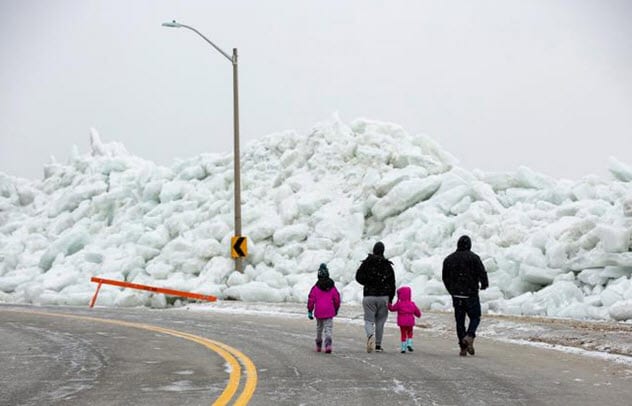
North American beaches sometimes meet with walls of ice. Despite their name, ice tsunamis do not move with the speed or devastation of real tidal waves. Technically, when heaps of ice clutter a beach, it is called an ice shove. The frosty phenomenon fringes the shorelines of large lakes, occurring when spring arrives and winds sweep the breaking ice outwards.
Some shoves are not satisfied with staying on the beach. When there is enough ice and strong winds, the stacks can overrun retaining walls and cross roads. A 2001 crush piled ice 4.9 meters (16 ft) high on the beach of Alaska’s Chukchi Sea.
The floes also have an interesting effect on large rocks at the bottom of the lake. When the frozen sheets expand and contract suddenly from temperature swings, they maneuver boulders onto the shore. This process forms what is known as ice-push ramparts, and they can measure 1.5 meters (5 ft) across.[2]
8 Monster Driftwood
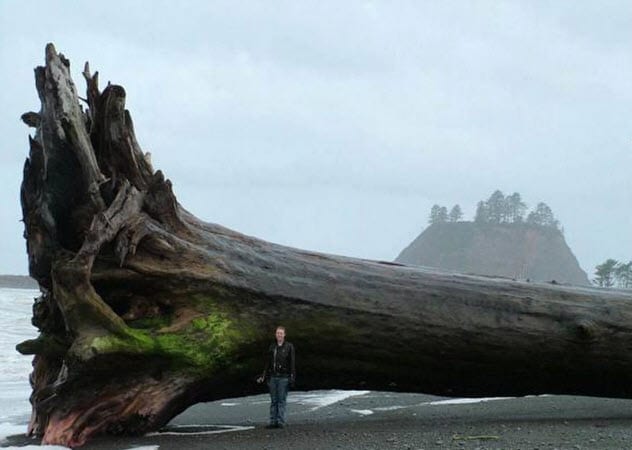
In 2010, Phillip Lachman and his daughter walked on the beach in Washington. Lachman, a retired teacher living in the nearby community of La Push, also had his camera with him. Which was a good thing as they found a pretty impressive piece of driftwood. When they come in this size, they are called drift logs.
The tree was never measured, but it dwarfed Lachman’s daughter who posed to have her picture taken next to it—and she was 183 centimeters (6’0″) tall. A park official from the surrounding Olympic National Park admitted that the size of the drift log was a rare sight even though the area is known for big forest trees.[3]
It was probably felled by a winter storm before bobbing down a river and ending up on the shore. It was not a simple matter of floating into place. Researchers estimated that exceptionally powerful winds had to have been present to push this monster ashore. The tree’s species could not be identified, but it was probably a Douglas fir, a Sitka spruce, or a Western red cedar.
7 Rare Jellies
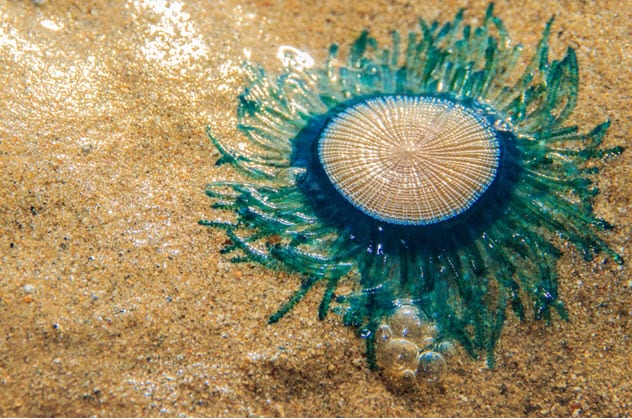
Holly Horner was a professional wildlife photographer. For 45 years, she walked the beach in Brigantine, New Jersey. In 2018, she encountered something that matched nothing in her experience. It was a bright turquoise creature, round and fringed with feather-like tendrils. It also resembled a jellyfish.
Several washed ashore and caused a sensation among beachgoers. However, scientists have already met the blobs. Called blue buttons, they are not jellyfish but are related to the Portuguese man-of-war instead. A single button hosts a predatory colony working together to stun prey. Luckily for swimmers, they do not have the same horrible sting as their Portuguese cousins.
The odd thing about the New Jersey buttons is that they are not native to the area. Researchers believe that they were happily bobbing about in the Gulf Stream when Hurricane Florence kidnapped them. Unfortunately, most of them likely perished in the following weeks when local temperatures dropped to a level to which they were not accustomed.[4]
6 The Wolf Island Creature
In 2018, the sea left something on the beach. The creature washed up in Georgia at the Wolf Island National Wildlife Refuge. Jeff Warren found and photographed the remains. After he distributed the images to media outlets, it divided the scientific world in two.
Some supported the notion of an unknown species or a known animal rendered unrecognizable by decomposition. Other marine experts were not satisfied that the thing had ever lived. The “decay” was too neat. There was no flayed skin, damaged extremities, or exposed internal areas. Ergo, the Lochness-like thing was probably a hoax.[5]
If this was someone’s idea of a joke, they chose the perfect location. The area is the haunt of a mythical creature called the Altamaha-ha Monster. The photographs matched artistic depictions of the animal, but the one thing that could have solved the case—the creature’s body—had vanished.
5 Human Urns
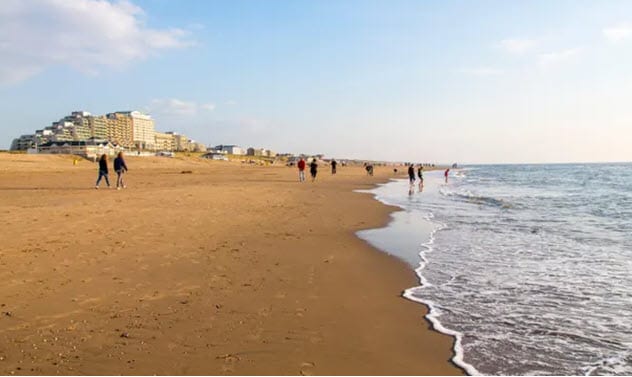
In 2019, a beachcomber took his 14-year-old son, Maarten, with him. They found a funeral urn, the first of three to show up on Katwijk and Noordwijk beaches in the Netherlands. The other two were discovered by a woman and a fisherman, respectively.
The teenager, Maarten, thought the urn might contain drugs. But once he opened the container, the content was clearly human remains. All three urns were marked, which allowed them to be traced back to a crematorium in Germany.
German laws surrounding human remains are very strict. Rarely will permission be given for ashes to remain in a private home or garden. Sea burials are permissible with biodegradable vessels, but the Dutch finds were made from aluminum.
The urns sparked a furious debate about how they ended up where they did. Then a Dutch shipping company came clean. The three urns had been aboard one of their ships. Had things gone according to plan, they would have scattered the ashes at sea. Instead, an employee accidentally dropped the box with the urns and it fell overboard.[6]
4 Frozen Turtles
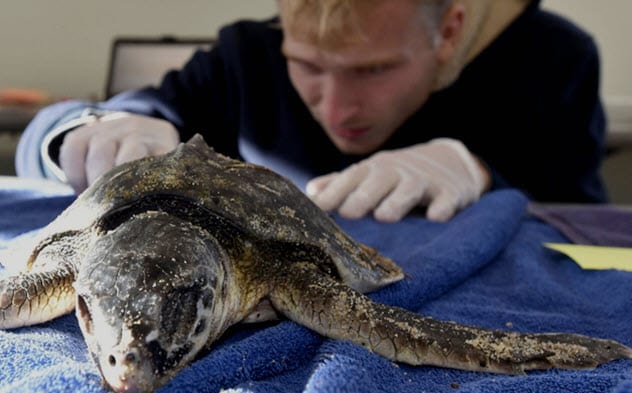
Every year in November, a few turtles become stranded in New England. The 2018 batch was far from normal. Hundreds washed ashore. Many were from the critically endangered Kemp’s ridley species. The reptiles had been caught in a cold snap, which was not a good thing for creatures needing warmth to function.
Cape Cod’s beaches counted 219 animals within three days. Only 46 clung to life, while the rest had already died. During one of the three days, the weirdest thing happened.[7]
On that Thursday, 82 turtles came ashore. Except for one, they were all dead and frozen solid. One researcher noticed that their flippers were in odd positions, almost as if they had been flash-frozen while swimming. The following day, a Friday, temperatures rose slightly and more of the beached turtles were found alive.
3 The French Goop
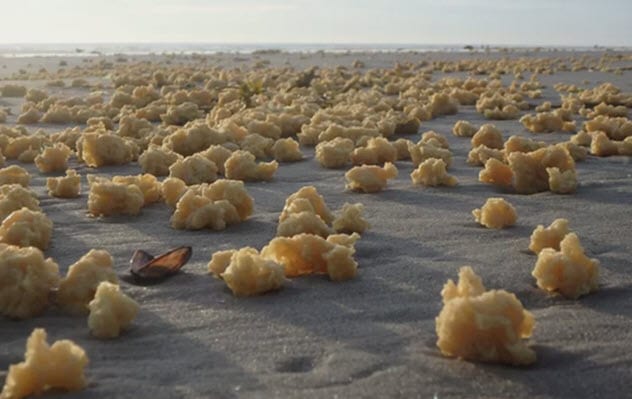
The English Channel coastline hugs a busy shipping lane. Strange things often float to its beaches, but none matched the greasy balls that arrived in 2017. Hundreds of yellow clumps lined miles of northern France’s beaches. There was a faint whiff of paraffin wax, but paraffin melts in the sun and this goop never did.
Authorities issued a statement that the spongy-looking balls were probably not dangerous. In the same breath, they could not positively say what the objects were made of. Pollution watchdogs were more realistic and warned people not to touch the stuff.[8]
Considering that tons littered miles of coastline, some beachgoers undoubtedly touched the gunk. Thankfully, no morgue reports were forthcoming. The only clue seemed to be that that fluff balls originated from an oil product. One theory suggested that it was some kind of boat exhaust grease that solidified once it came into contact with the cold seawater.
2 Tons Of Invasive Life
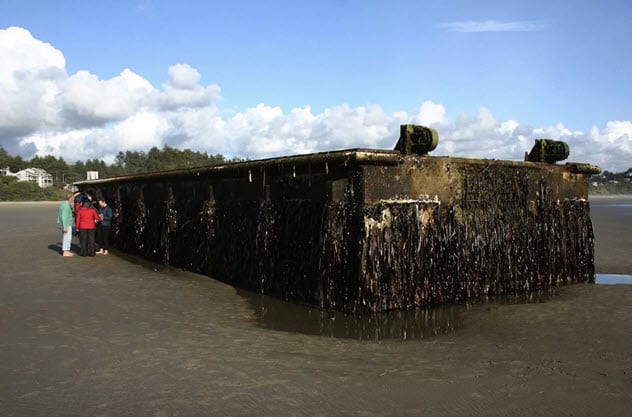
When the Tohoku earthquake and tsunami hit Japan in 2011, a lot of debris got sucked back into the sea. A year later, one such item floated into Oregon. The Japanese dock measured 20 meters (66 ft) long and was encrusted with 100 tons of sea life.
This may sound peachy, but scientists were horrified. There is a huge problem in the area with invasive species, some so aggressive that native creatures cannot compete. Environmentally speaking, the tsunami dock was a ticking bomb. The floating “island” had an astonishing variety of anemones, starfish, urchins, algae, crustaceans, worms, snails, mussels, and much more.
Most had already called the dock home before the tsunami hit. After it was torn from its moorings, the float picked up more hitchhikers at sea. Admirably, the dock’s teeming citizens survived traveling across the open Pacific.
However, they were destroyed to prevent the threat they posed to native species. The threat may still be realized—some could have dropped off the dock earlier and already settled into Oregon’s shores.[9]
1 Garfield Phones
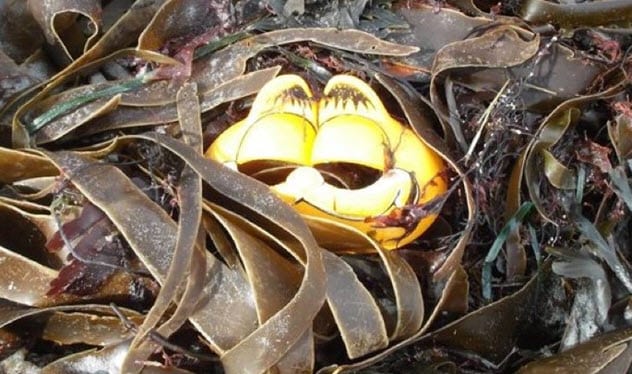
Garfield the cat is a cartoon icon. During the 1980s, a company created novelty Garfield phones that became very popular. Mysteriously, they started to appear along the coastline of France. The feline flotsam invaded French beaches for decades, long after the phone’s popularity had passed.
In 2019, environmentalists finally found the source. A local man knew the secret all along—only it was not a secret to him. After learning that the rest of humanity considered the washed-up Garfields a mystery, Rene Morvan told his story.[10]
In the 1980s, he and his brothers had explored a seaside cave. They found a shipping container inside. Among other things, it contained an enormous number of the Garfield phones.
Morvan took the anti-litter organization Ar Viltansou to the site, where they found the plastic cats and the container. Records show that a local storm raged around the time that the Morvan brothers made the discovery. The storm probably knocked the container off a passing ship and crushed it into the cave.
Read about more mysterious and unusual shoreline and underwater finds on 10 Bizarre Things That Washed Up On Beaches and 10 Mysterious Underwater Cities You Haven’t Heard Of.








